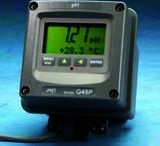
PH/Redox measurement - Q45P/R
ATI's versatile Q45P/R pH/ORP system is designed for use in all industrial and municipal applications. The sensors are engineered to function normally in applications where conventional sensors quickly fail. Conventional pH/ORP sensors have an “open reference system,” which means the reference element and electrolyte are in contact with the process. This allows chemicals to diffuse into the reference chamber and alter the reference system. As the reference junction becomes contaminated, the reference potential shifts. As chemicals attack the silver reference wire, the reference potential shifts and the sensor no longer functions. When any of these problems occur, cleaning and calibration cycles increase and the sensors fail much faster, all of which costs you time and money.
The differential pH/ORP sensors utilize a “sealed reference system,” where the sensors are constructed with a second glass pH electrode as the reference element. The glass reference system protects the sensor from chemical poisons (sulfide, cyanide, chlorine, bisulfite, etc.) that destroy conventional pH sensors. A large volume, dual junction saltbridge is used to maximize the in-service time of the sensor. Large electrolyte volume and dual junctions minimize contamination of the reference solution. The replaceable saltbridge allows for easy and inexpensive sensor regeneration.
The Q45P/R Auto-Clean System is designed to extend sensor cleaning intervals on pH and ORP sensors that are mounted in applications containing high levels of solids contamination. The Auto-Clean System uses high pressure air to remove contaminants from the face of the sensor automatically. Our Auto-Clean System utilizes a self contained compressor and air cylinder to generate a series of high pressure air blasts. Each cleaning cycle lasts approximately 2 minutes, during which the monitor outputs are placed in a HOLD condition to prevent false readings or alarms. The concentration of solids in the process will determine the cleaning frequency of the system. The user can vary the cleaning cycle frequency from as often as once every two hours to as little as once a day.
 Model Q45P ph/ORP 4,8 MB
Model Q45P ph/ORP 4,8 MB
Application
water quality measurement
REQUEST
Request information
Request quotation



